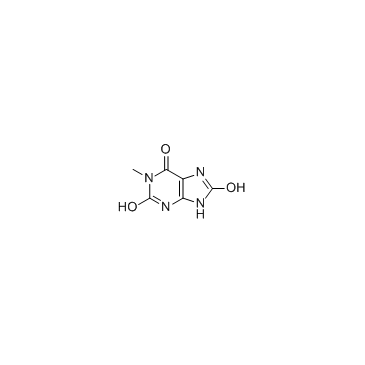1-Methyluric acid

1-Methyluric acid structure
|
Common Name | 1-Methyluric acid | ||
|---|---|---|---|---|
| CAS Number | 708-79-2 | Molecular Weight | 182.13700 | |
| Density | 1.73g/cm3 | Boiling Point | 315.51°C (rough estimate) | |
| Molecular Formula | C6H6N4O3 | Melting Point | >325ºC | |
| MSDS | Chinese USA | Flash Point | N/A | |
|
Altered age-related changes in bioenergetic properties and mitochondrial morphology in fibroblasts from sporadic amyotrophic lateral sclerosis patients.
Neurobiol. Aging 36 , 2893-903, (2015) Mitochondria play a key role in aging, which is a well-established risk factor in amyotrophic lateral sclerosis (ALS). We have previously modeled metabolic dysregulation in ALS using fibroblasts isolated from sporadic ALS (SALS) and familial ALS patients. In ... |
|
|
Pyogranulomatous pneumonia in goats caused by an undescribed Porphyromonas species, "Porphyromonas katsikii".
J. Clin. Microbiol. 53(3) , 795-8, (2015) A yet-undescribed bacterial species, tentatively named "Porphyromonas katsikii," was isolated from individuals of a small goat herd with pyogranulomatous pneumonia during an outbreak of acute respiratory disease. The isolated bacteria grew in the form of blac... |
|
|
Phenotyping of N-acetyltransferase type 2 and xanthine oxidase with caffeine: when should urine samples be collected?
Eur. J. Clin. Pharmacol. 65(4) , 411-7, (2009) Individual activities of N-acetyltransferase 2 (NAT2) and of xanthine oxidase (XO) can be assessed using ratios of urinary caffeine metabolites. We investigated how ratios changed over time and which urine collection interval would be the best for NAT2 and XO... |
|
|
Concordance between the deduced acetylation status generated by high-speed: real-time PCR based NAT2 genotyping of seven single nucleotide polymorphisms and human NAT2 phenotypes determined by a caffeine assay.
Clin. Chim. Acta 376(1-2) , 240-3, (2007) The utility of typing single nucleotide polymorphisms (SNPs) for the determination of the N-acetyltransferase 2 (NAT2) acetylation status is a matter of debate.Evaluation of the concordance between deduced genotype results of seven human NAT2 SNPs generated b... |
|
|
Phenotyping of N-acetyltransferase type 2 by caffeine from uncontrolled dietary exposure.
Eur. J. Clin. Pharmacol. 60(1) , 17-21, (2004) The standard approach for phenotyping of the human arylamine N-acetyltransferase 2 (NAT2) uses urinary caffeine metabolite ratios after a caffeine test dose taken in after methylxanthine abstinence. We tested whether these standardization measures were still ... |
|
|
Inhibition of CTP synthase from Escherichia coli by xanthines and uric acids.
Bioorg. Med. Chem. Lett. 20 , 141-4, (2010) CTP synthase (CTPS) catalyzes the conversion of UTP to CTP and is a recognized target for the development of anticancer, antiviral, and antiprotozoal agents. Xanthine and related compounds inhibit CTPS activity (IC(50)=0.16-0.58mM). The presence of an 8-oxo f... |
|
|
Caffeine N3-demethylation (CYP1A2) in a population with an increased exposure to polychlorinated biphenyls.
Eur. J. Clin. Pharmacol. 62(12) , 1041-8, (2006) To investigate the CYP1A2 phenotype distribution in a population with an increased exposure to polychlorinated biphenyls (PCBs) that would likely induce an increased activity of this enzyme. Further, to investigate the effect of sex, smoking, and oral contrac... |
|
|
Uric acid may inhibit glucose-induced insulin secretion via binding to an essential arginine residue in rat pancreatic beta-cells.
Bioorg. Med. Chem. Lett. 15 , 1181-4, (2005) Uric acid (1a) suppresses basal insulin release in isolated rat pancreatic islets and inhibition of glucose-stimulated insulin secretion (GSIS) occurs right at hyperuricaemic levels (0.4 mM). Conversely, 1 mM guanidinium urate (2a) was completely ineffective,... |
|
|
Stimulatory effect of luteinizing hormone, insulin-like growth factor-1, and epidermal growth factor on vascular endothelial growth factor production in cultured bubaline luteal cells.
Theriogenology 84 , 1185-96, (2015) The purpose of this study was to evaluate the temporal (24, 48, and 72 hours) and dose-dependent (0, 5, 10, and 100 ng/mL of LH, insulin-like growth factor 1 [IGF-1], and EGF) in vitro expression and secretion patterns of vascular endothelial growth factor (V... |
|
|
Caffeine metabolism differences in acute hepatitis of viral and drug origin.
Therapie. 55(5) , 619-27, (2000) The 24-h urinary excretion rate of caffeine metabolites following 200 mg caffeine intake has been proved to be a valuable safe quantitative test of liver function. The pathological mechanism of acute hepatitis of viral and drug origin is different. In both di... |